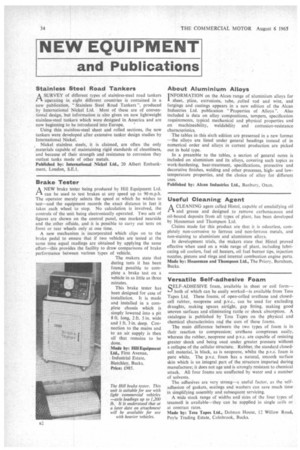NEW EQUIPMENT
Page 36

If you've noticed an error in this article please click here to report it so we can fix it.
and Publications
Stainless Steel Road Tankers ASURVEY of different types of stainless-steel road tankers operating in eight different countries is contained in a new publication, "Stainless Steel Road Tankers ", produced by International Nickel Ltd. Most of these are of conventional design, but information is also given on new lightweight stainless-steel tankers which were designed in America and are now beginning to be introduced into Europe.
Using thin stainless-steel sheet and rolled sections, the new tankers were developed after extensive tanker design studies by International Nickel.
Nickel stainless steels, it is claimed, are often the only materials capable of maintaining rigid standards of cleanliness, and because of their strength and resistance to corrosion they outlast tanks made of other metals.
Published by: International Nickel Ltd., 20 Albert Embankment, London, S.E.1.
Brake Tester ANEW brake tester being produced by Hill Equipment Ltd. can be used to test brakes at any speed up to 90 m.p.h. The operator merely selects the speed at which he wishes to test—and the equipment records the exact distance in feet it takes each wheel to stop. No calculation is involved, the controls of the unit being electronically operated. Two sets of figures are shown on the control panel, one marked nearside and the other offside, and it is possible to carry out tests on front or rear wheels only at one time.
A new mechanism is incorporated which clips on to the brake pedal to ensure that if two vehicles are tested at the same time equal readings are obtained by applying the same effort—this provides the facility to draw comparisons of brake performance between various types of vehicle.
The makers state that during tests it has been found possible to complete a brake test on a vehicle in as little as three minutes.
This brake tester has been designed for ease of installation. It is made and installed in a complete chassis which is simply lowered into a pit 8 ft. long, 2 ft. 5 in. wide and 1 ft. 3 in. deep. Connection to the mains and to an air supply is then all that remains to be done.
Made by: Hill Equipment Ltd., First Avenue, Industrial Estate, Bletchley, Bucks.
Price: £985.
About Aluminium Alloys
INFORMATION on the Alcan range of aluminium alloys for sheet,, plate, extrusions, tube, foiled rod and wire, and forgings and castings appears in a new edition of the Alcan Industries Ltd. publication "Properties of Alloys ". Also included is data on alloy compositions, tempers, specification requirements, typical mechanical and physical properties and on machineability, weIdability and corrosion-resistance characteristics.
The tables in this sixth edition are presented in a new format —the alloys are listed under general headings instead of in numerical order and alloys in current production are picked out in bold type.
In a preamble to the tables, a section of general notes is included on aluminium and its alloys, covering such topics as work-hardening, heat-treatment, specifications, protective and decorative finishes, welding and other processes, highand lowtemperature properties, and the choice of alloy for different uses.
Published by: Alcan Industries lAd., Banbury, Oxon.
Useful Cleaning Agent A CLEANING agent called Histol, capable of emulsifying oil and grease and designed to remove carbonaceous and oil-bound deposits from all types of plant, has been developed by Houseman and Thompson Ltd.
Claims made for this product are that it is odourless, completely non-corrosive to ferrous and non-ferrous metals, and non-staining to aluminium and aluminium alloys.
In development trials, the makers state that Histol proved effective when used on a wide range of plant, including lubricating oil coolers, fuel oil heaters, oil fuel burner tips, injection nozzles, pistons and rings and internal combustion engine parts. Made by: Houseman and Thompson Ltd., The Priory. Burnham, Bucks.
Versatile Self-adhesive Foam gELF-ADHESIVE foam, available in sheet or coil form—
both of which can be easily worked—is available from Tesa Tapes Ltd. These foams, of open-celled urethane and closedcell rubber, neoprene and p.v.c., can be used for excluding draughts, making spaces airtight, gap fitting, making good uneven surfaces and eliminating rattle or shock absorption. A catalogue is published by Tesa Tapes on the physical and chemical characteristics and the uses of these foams.
The main difference between the two types of foam is in their reaction to compression; urethane compresses easily, whereas the rubber, neoprene and p.v.c. are capable of resisting greater shock and being used under greater pressure without a collapse of the cellular structure. Rubber, the standard closedcell material, is black, as is neoprene, whilst the p.v.c. foam is pure white. The p.v.c. foam has a natural, smooth surface skin which is an integral part of the structure imparted during manufacture; it does not age and is strongly resistant to chemical attack. All four foams are unaffected by water and a number of solvents.
The adhesives are very strong—a useful factor, as the selfadhesion of gaskets, seatings and washers can save much time in simplifying assembly and subsequent servicing.
A wide stock range of widths and sizes of the four types of tesamoll is available—they can be supplied in single coils or at contract rates.
Made by: Tess Tapes Ltd, Dolman House, 12 Willow Road, Poyle Trading Estate, Colnbrook, Bucks.












































































































